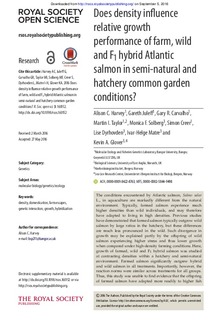| dc.contributor.author | Harvey, Alison C. | |
| dc.contributor.author | Juleff, Gareth | |
| dc.contributor.author | Carvalho, Gary R. | |
| dc.contributor.author | Taylor, Martin I. | |
| dc.contributor.author | Solberg, Monica Favnebøe | |
| dc.contributor.author | Creer, Simon | |
| dc.contributor.author | Dyrhovden, Lise | |
| dc.contributor.author | Matre, Ivar Helge | |
| dc.contributor.author | Glover, Kevin | |
| dc.date.accessioned | 2016-09-05T12:15:55Z | |
| dc.date.accessioned | 2016-09-15T11:01:38Z | |
| dc.date.available | 2016-09-05T12:15:55Z | |
| dc.date.available | 2016-09-15T11:01:38Z | |
| dc.date.issued | 2016-07-06 | |
| dc.identifier.citation | Royal Society Open Science 2016, 3:160152(7) | nb_NO |
| dc.identifier.issn | 2054-5703 | |
| dc.identifier.uri | http://hdl.handle.net/11250/2407498 | |
| dc.description | - | nb_NO |
| dc.description.abstract | The conditions encountered by Atlantic salmon, Salmo salar L., in aquaculture are markedly different from the natural environment. Typically, farmed salmon experience much higher densities than wild individuals, and may therefore have adapted to living in high densities. Previous studies have demonstrated that farmed salmon typically outgrow wild salmon by large ratios in the hatchery, but these differences are much less pronounced in the wild. Such divergence in growth may be explained partly by the offspring of wild salmon experiencing higher stress and thus lower growth when compared under high-density farming conditions. Here, growth of farmed, wild and F1 hybrid salmon was studied at contrasting densities within a hatchery and semi-natural environment. Farmed salmon significantly outgrew hybrid and wild salmon in all treatments. Importantly, however, the reaction norms were similar across treatments for all groups. Thus, this study was unable to find evidence that the offspring of farmed salmon have adapted more readily to higher fish densities than wild salmon as a result of domestication. It is suggested that the substantially higher growth rate of farmed salmon observed in the hatchery compared with wild individuals may not solely be caused by differences in their ability to grow in high-density hatchery scenarios. | nb_NO |
| dc.language.iso | eng | nb_NO |
| dc.publisher | The Royal Society | nb_NO |
| dc.rights | Navngivelse-DelPåSammeVilkår 3.0 Norge | * |
| dc.rights.uri | http://creativecommons.org/licenses/by-sa/3.0/no/ | * |
| dc.title | Does density influence relative growth performance of farm, wild and F1 hybrid Atlantic salmon in semi-natural and hatchery common garden conditions? | nb_NO |
| dc.type | Journal article | nb_NO |
| dc.type | Peer reviewed | nb_NO |
| dc.date.updated | 2016-09-05T12:15:55Z | |
| dc.source.journal | Royal Society Open Science | nb_NO |
| dc.identifier.doi | 10.1098/rsos.160152 | |
| dc.identifier.cristin | 1374815 | |
| dc.relation.project | EU/311920 | nb_NO |

